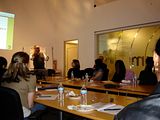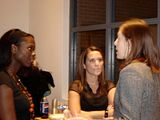6:00-6:30 P.M. - Networking
6:30-7:30 P.M. - Program
MWW Group
660 S. Figueroa Street, Suite 1400
Los Angeles, CA 90017
As Account Lead for the Interpublic Emerging Media Lab - focusing specifically on the mobile marketing space - Michael Ball works with partner agencies to help clients build their brands and strategic position in new media. His experience includes interactive projects for Acura / Honda, Girl Scouts, Lexus, PNC Bank, Amgen, Anheuser-Busch, Benjamin Moore, FedEx, Dell, Proctor & Gamble, Unilever, Accenture and Nestle. An active writer and speaker, Michael has published two career books for recent college graduates, and serves as a media expert on entry level jobs for sources including the Washington Post, Minneapolis Star Tribune, CareerJournal.com and the Globe and Mail in Canada.
As Supervisor, New Media and Marketing, at JMPR, Public Relations, Mike Hudson, oversees the new media activity for JMPR’s internal account teams and internationally recognized accounts. Prior to joining JMPR, Hudson served as an editor at Edmunds.com, where he was News Editor of Inside Line, Edmunds’ auto enthusiast online magazine. Here Hudson designed the Web site’s new filtration system and live publishing capabilities.
Jennifer Dekel is an Assistant Account Executive at Schwartzman & Associates, a Los Angeles-based agency specializing in integrating blogs, podcasts and other new media platforms into conventional PR campaigns for corporate entertainment, media and technology clients. Dekel is responsible for news media research and agency account support and has worked on supporting clients including Associated Production Music, Ecast, GenCon, Hidden City Games and Rearden Companies. She is also the assistant producer of the award-winning PRSA podcast, “On the Record...Online.”
Parking:
Public parking lot on right side of Figueroa Street, right after you pass 8th Street (located behind Bank of America and across street from Ann Taylor). Cost is $5 (CASH ONLY) after 4 p.m. for parking.
Building Access:
All meeting attendees will need to enter the building at the 7th street entrance and use the intercom to the right of the doors to request access to building. They can tell the security attendant they are here for the YP meeting at MWW Group in Suite 1400. Once inside, take the elevators to the Sky Lobby (button in elevator is marked “SL”), where they will check in and present photo ID to the security guard who then give them access to our floor.
Cost (pay by cash or checks at the door):
$10 YP Members; $15 for Non- members; $5 for PRSSA Members
RSVP:
To RSVP, please reply to this email by Monday, March 19th. If you have any questions, please contact Bonnie Berkes at bberkes@jmprpublicrelations.com or Phyllis Hu at phu@iwgroupinc.com.
We Hope to See You There!
Phyllis Hu (IW Group) & Bonnie Berkes (JMPR, Public Relations)
Program Co-Chairs, PRSA-LA's Young Professionals
email: yp_prsala@yahoo.com
web: http://www.prsa-la.org



